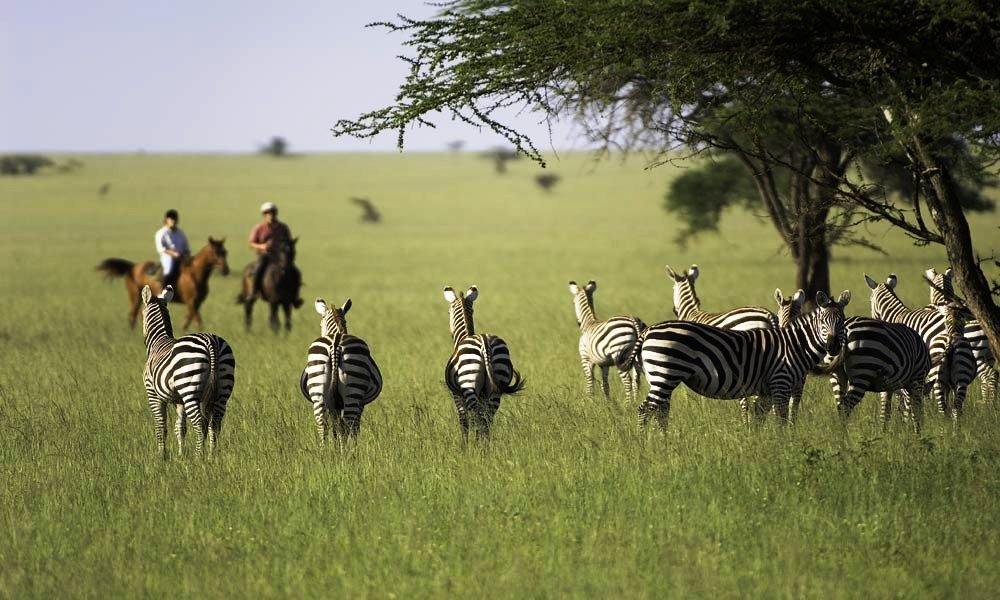The equatorial sun beats down without mercy as I guide Elaine, a walnut-brown mare with a dark mane, through tangled acacia thorns and thick brush. It’s been a long day riding, and my thighs are sore. Our camp waits just beyond a ridge of time-worn, folded hills in Kenya’s Lolldaiga Range—a patchwork of landscapes and communities woven together.
Then Elaine’s ears twitch, sharp as antennae, and her muscles tighten beneath me. Our guide, Nicholus Nangunye Tuta, lifts a slender arm toward a bush just a few meters away. I squint, struggling to spot what the others already see: two golden eyes gleaming from the shadows. A young lion, lithe and powerful, crouches in the tall grass.
A heavy silence settles over us.
Without the safety of a safari vehicle’s high wheels and metal frame, I feel utterly vulnerable. Staring into the bush, I’m caught between awe and fear—the space between me and the savannah’s most feared hunter absurdly small. Normally, I’m the one tracking lions, camera ready. But now, the lion shifts in my mind from something I observe to something that observes me. I tense, hyper-aware of my own fragile body.
Nearby, guide Hamprey Mweterwa and riders Llewellyn Dyer and Tatiana Rose Dyer thunder over a hill in Kenya’s Borana Conservancy.
A mother giraffe and her calf browse for food in Borana Conservancy. Wild giraffe numbers have risen sharply since 2015.
A dominant male lion lounges at dusk, fresh from clashes with rival males.
Nicholus tilts his head toward safer ground, then gestures at marks in the dirt. “See? A big lion’s tracks—and here, smaller ones, cubs,” he murmurs. “Likely a mother.” Pawprints scatter across the earth, each telling of more lions moving in different directions. Time to leave.
In Kenya, where horseback safaris began in the 1970s, they remain the most intimate way to experience wildlife. Riding here dissolves barriers—meant to protect us, but also to keep nature at arm’s length. And as we lose ourselves in the thrill, we’re starkly reminded why protecting these wild places matters.
Out here, your horse is your interpreter, attuned to a leopard’s hushed growl, the musky trace of elephants, or the crisp wind rolling down Mount Kenya’s icy slopes. Your task? Learn to listen.
Safari tourism and conservation
The next morning, we saddle up and form a single-file line, chatter fading as we enter a forest dappled with sunlight. African olive trees mingle with towering cedars, and wild orchids cling to branches. The terrain looks rough, but this path was carved by elephants, winding through the trees like a lazy river.
The wilderness around Lolldaiga Hills doubles as a working cattle ranch and a hub for research.
Rounding a bend, the jagged silhouette of Mount Kenya emerges. Three million years ago, this volcano erupted from the earth, once towering at 23,000 feet before erosion wore it down. The Kikuyu, who revered it as sacred, first named it Kirinyaga. Now, it’s the tallest peak in the country that bears its name.
Ice still glints on its basalt peaks, though its glacier has shrunk by 90% in the last 80 years. The fertile highlands give way here to a starker beauty—scattered trees, dry plains, lone mountains. Farmland turns to pasture.
Like many Kenyan conservancies, Borana started as a cattle ranch, though herders had grazed here for millennia. For the Maasai, Samburu, and Pokot, cattle were life—culture and currency. But when parks and conservancies arose in the mid-20th century, these communities lost access to ancestral grazing lands.
Now, Borana works closely with neighbors through programs like Mazingira Yetu (“our environment” in Swahili), teaching stewardship. Local students visit for game drives, ranger talks, and lessons on water storage, regenerative farming, and tree nurseries. Launched in 2022 with 365 students, the program hosted over 1,100 in 2023.
Borana pours all profits into conservation. Last year, tourism brought over $1 million, funding protection for 28 endangered species, training for 114 rangers, scholarships for 55 students, and drought aid for seven communities. But there’s a growing understanding: real change needs collaboration across borders and interests.
A northern white rhino and her calf graze at dusk in Borana, one of Kenya’s most successful rhino sanctuaries.
Meeting rhinos
On my last day at Borana, Elaine and I top a rise, and her deep brown eyes fix on two gray shapes ahead. A rhino calf and its mother, who steps slowly between us and her baby.
Elaine stops. The two study each other. It’s strange—evolution made them closest living relatives. A silent understanding passes between them. We keep our distance; the rhinos keep grazing. Slumping in the saddle, I notice not their differences but their shared traits: thoughtful eyes, sturdy jaws, that rolling walk.
Riders pause to watch elephants during a Borana-to-Lolldaiga safari.
Nature’s diversity astounds, offering endless lessons in its contrasts—and unexpected kinships. As the sun sinks behind the hills, I tap Elaine’s side. She turns from the unbothered rhinos, and we amble back.
